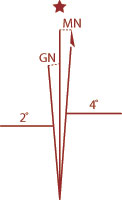How to Use a Map and Compass
Want to win your next orienteering challenge?
Get prepared by studying basic map-and-compass skills such as taking a bearing. Then move on to more advanced techniques such as aiming off and factoring in declination as you navigate your way through the course.
HOW TO TAKE A COMPASS BEARING
Let’s say you know roughly where you are on a map, for example Campsite 22, and you want to get to Campsite 23. You could always just start walking in that general direction. But there’s a more accurate way to figure out which way to go. It’s called taking a bearing.
Learn how in the following video:
1. Put your compass down on a flat surface and align one edge of the compass with your starting point — in this case, Camp 22. Align the forward edge of the compass with your destination, Camp 23.
2. Turn the compass housing until north on the dial is aligned with north on your map. The direction you need to go — in this case, 60 degrees — can now be read on the compass base where it’s aligned with the direction arrow.
3. Now stand up and hold the compass in front of you near your midsection with the direction arrow pointing away from you at a 90-degree angle. Rotate your body — and the compass with it — until the magnetic compass needle is aligned with the “N” on the dial. You should now be pointing in the right direction, in this case 60 degrees toward Campsite 23.
4. Follow the arrow on the compass to your destination. As you’re walking, stop and take your bearings again to make sure you don’t drift off course.
AIMING OFF IN ORIENTEERING
In some cases, going from Point A to Point B isn’t as easy as it might seem. Let’s say the terrain between your current location and your intended destination consists of rolling hills, streams too deep to wade across and vegetation so thick that you have to go around.
Face it: You aren’t going to be able to maintain a straight course. A veteran of orienteering will instead aim off to the left or right of their destination as it appears on the map to hit some permanent landmark, such as a road or stream.
Then, even if you don’t make it straight to your target, you’ve purposefully aimed off to one side, so you know you have a relatively short walk down the stream or road to get where you need to go.
For example: Let’s say you don’t want to risk hiking through some water and thick underbrush that lies between Points A and B on the map. Instead, purposefully aim off to the right, around Point C.
Even if you miss Point C by a good bit, you know you’re going to walk southwest on the road until you get to your destination.
Tip: It’s important to keep track of where you are all the time, especially when the distance between Point A and Point B (or C) is significant. Use attack points at which you stop and compute your bearings. Choose easily identifiable spots on the map as attack points — the edge of a pond, the end of a road, etc. Remember to add about a minute to your travel time for each time you check your compass.
WHAT ABOUT DECLINATION?
Taking a bearing with a map and compass will show you the relative direction from Point A to Point B. The actual direction, as related to true north and south, is different.
The north magnetic pole is actually about 1,200 miles southwest of the true North Pole. Therefore, magnetic north — the spot to which your compass points — is not the same as true north.
The difference is called declination.
In some cases, the difference between magnetic north and true north is so slim that it isn’t going to greatly affect your course. But, depending on where you are and how far you’re going, factoring in declination can save you some major headaches down the road.
Declination varies depending on where you are. Every topographic map should include a declination diagram.
On this map, magnetic north is 4 degrees east of true north. To factor declination into your bearings, you would subtract 4 degrees from your bearing.
 The declination diagram here also indicates grid north: the direction of the grid lines on the map, which don’t point to true north either.
The declination diagram here also indicates grid north: the direction of the grid lines on the map, which don’t point to true north either.
In this case, grid north is 2 degrees west of true north. So if you take a bearing from your map using grid lines, convert it to a magnetic bearing by adding 6 degrees — 2 degrees to true north and then 4 more to magnetic north.
Tip: Declination diagrams aren’t always drawn to scale, so don’t use them to adjust your bearing. You have to do it the old-fashioned way — with math.
Tip two: Some orienteering veterans draw their own lines on their map that run parallel to the north magnetic pole and use them instead of the grid lines that are already on the map. But the bigger the map, the harder it is to accurately draw a straight line, which means it’s best to use — you guessed it — math.
Might be good to have scouts review this to find the major “error” in the video, and estimate on the map where these two scouts really ended up.
Also, don’t forget the power of landmark check pointing when navigating.